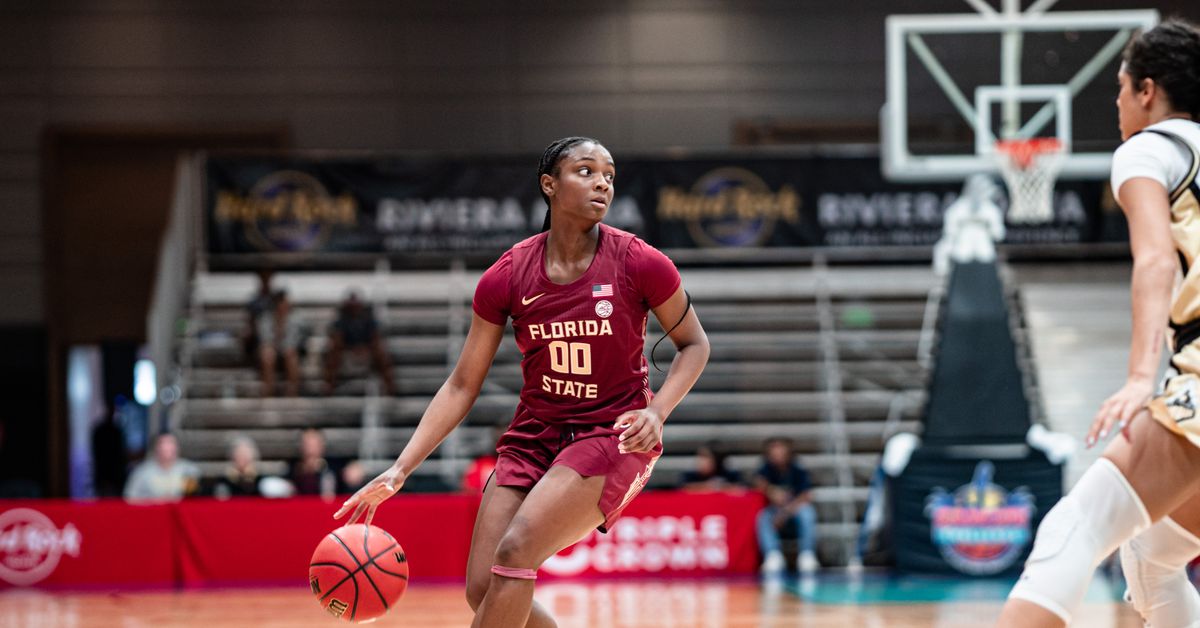I walked into the Mirage Hotel in Las Vegas Friday morning to cover the Las Vegas Invitational basketball tournament, and the place was overwhelming. I began asking employees where the event was, and person after person either said they didn’t know, directed me to someone else, or misdirected me to what they thought I was talking about.
Eventually I found the right ballroom, after walking for quite a distance that included a lot of turns. There were no signs indicating where to go; I followed some players that I finally spotted, and as I got closer, I saw parents in athletic clothing.
I walked through the door and couldn’t believe the setup: a court in a ballroom surrounded by a single row of cushioned chairs, some tables at each end, and some scaffolding where a few people stood, presumably to film the event for the Flohoops broadcast.
Two scoreboards sat at court level, each tilted toward one of the player benches, as is commonly done during high school games and AAU tournaments. The lighting was dim, and it was hard for most to see the score at any given time.
There was no media seating – heck, there was barely any seating at all, and most of the family members of the players, and others, stood during games. I had driven from Los Angeles to cover the tournament, but these people had flown in from New York, Tennessee, Texas and other distant cities. And for all their trouble, there was no seat for them.

I finally took a spot at one of the end tables, near the MTSU bench. There were no outlets where I could plug in my laptop. The ballroom was freezing. There was no water available anywhere. “Locker rooms” were rooms behind the bench that were accessed by going out a door, through a long hallway, and into another room.
In the middle of the second game, my laptop started to die, and I decided to go back to my hotel for a while and return for the matchup between No. 6 Indiana and Auburn. It began almost an hour late, at 6:40 p.m. instead of 5:45 p.m., and within the first two game minutes, Hooiser point guard Grace Berger went down with a knee injury.
Team personnel attended to the senior, who returned to the bench a while later with her knee wrapped in ice. There was no medical personnel on hand at the event, nor was there the next night when Auburn forward Kharyssa Richardson went down with an injury, stopping play for about 40 minutes. She was taken to a local hospital as a precaution.
I was sitting near the Hoosier bench during their matchup with the Tigers, and there was an instance when the shot clock suddenly stopped. One of the members of the officiating crew, who was sitting next to me, jumped up and told her associate on the court that the plug had popped out again – right next to us – as people walked by.
“It’s been happening all day,” the referee said, as she fixed it.
I looked down and realized why: none of the cords were taped to the floor, as is standard. It was yet another surreal moment of the day.
So was finding out that there was no press room. I conducted one interview in a banquet room several doors down from the room the court was in. Players and coaches were answering questions on Zoom, too.

Teams had apparently been told that there would be a formal setup at the event, similar to that of Athletes United. The tournament had formerly been called the South Point Shootout, but had been moved to the Mirage and would be in a ballroom. But no team expected the crude arrangements, the lack of security, and the complete ignorance of details. One group, apparently not confident in the safety of their “locker room,” lined up their backpacks behind their bench, as players undoubtedly did in high school.
It was insulting. I’ve been to better AAU and high school gyms, and this event had the No. 6 team in the country on hand, in Indiana.
The organization putting on the event is run by Bryce McKey, who was not present. The representative of the organization who ran operations talked to me Saturday, but didn’t want to be identified beyond being “a worker.” Yet this person talked to ESPN’s M.A. Voepel and identified himself.
He told me that the tournament had been planned two years ago, after which time the Mirage had been sold to the Hard Rock Corporation, who didn’t want to do the event. This conflicts with an email from a sports information director from one of the teams that I wrote to in September about the event, who said that “It’s the tournament usually called the South Point Shootout. They had to move it to the Mirage this year – where apparently it will be played in a ballroom – so they had to change the name of it.”
Whatever the case, a Division I tournament that includes Power 5 and mid-major teams has no place in a hotel ballroom.
The “worker” also told me Saturday that he had apologized to each coach at this weekend’s event, and said that the company was done and would never host the tournament again.

In late summer, when I was planning to make the trip, I was trying to scope out other Division I women’s basketball tournaments in Las Vegas. I wrote to the NCAA and asked if they had a list of sanctioned tournaments that I could look at. They did not seem to know what I was talking about. It wasn’t until the week before my trip that I found out there were two other events in the city that week. I wish I had known about that before.
And I have questions.
Why doesn’t the NCAA have a list of all of the tournaments that teams will be participating in? Why does an organization that doesn’t have trouble regulating most other things seem to have no formal vetting process for events that athletes participate in? Where is the bar for minimum standards? Are they really trying to protect student-athletes? And why is Title IX still not being enforced 50 years after that fact?
Female athletes deserve fair and equal treatment. And they should be able to be confident that their best interests are in the hearts of those who are supposed to be safeguarding them.














